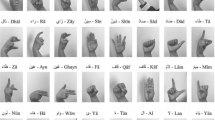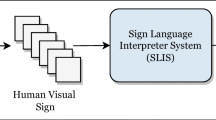Abstract
Arabic Sign Language (ArSL) is the most utilized for hearing and speech impairments in Arab countries. The recognition system of ArSL could be an innovation to empower communication between the deaf and others. Recent advances in gesture recognition using deep learning and computer vision-based techniques have proved promising. Due to a lack of ArSL datasets, the ArSL dataset was created. The dataset was then expanded using augmentation methods. This paper aims to create an architecture based on both Transfer Learning (TL) models and Recurrent Neural network (RNN) models for recognizing ArSL. The extraction of spatial and temporal data was accomplished by combining TL and RNN models. Furthermore, the hybrid models outperformed current architectures when tested on both the original and augmented datasets. More overall, the highest recognition accuracy of 93.4% was attained.
Access this chapter
Tax calculation will be finalised at checkout
Purchases are for personal use only
Similar content being viewed by others
Notes
References
Bragg, D., et al.: Sign language recognition, generation, and translation: an interdisciplinary perspective. In: The 21st International ACM SIGACCESS Conference on Computers and Accessibility, pp. 16–31 (2019)
Xu, S., Liang, L., Ji, C.: Gesture recognition for human–machine interaction in table tennis video based on deep semantic understanding. Signal Process. Image Commun. 81, 115688 (2020)
Wu, Z., Yao, T., Fu, Y., Jiang, Y.-G.: Deep learning for video classification and captioning. In: Frontiers of Multimedia Research, pp. 3–29 (2017)
Das, S., Chaudhary, A., Bremond, F., Thonnat, M.: Where to focus on for human action recognition? In: 2019 IEEE Winter Conference on Applications of Computer Vision (WACV), pp. 71–80. IEEE (2019)
Tolentino, L.K.S., Juan, R.S., Thio-ac, A.C., Pamahoy, M.A.B., Forteza, J.R.R., Garcia, X.J.O.: Static sign language recognition using deep learning. Int. J. Mach. Learn. Comput. 9(6), 821–827 (2019)
Jiang, X., Lu, M., Wang, S.-H.: An eight-layer convolutional neural network with stochastic pooling, batch normalization and dropout for fingerspelling recognition of Chinese sign language. Multimedia Tools Appl. 79(21), 15697–15715 (2020). https://doi.org/10.1007/s11042-019-08345-y
Ameen, S., Vadera, S.: A convolutional neural network to classify American sign language fingerspelling from depth and colour images. Expert Syst. 34(3), e12197 (2017)
Cayamcela, M.E.M., Lim, W.: Fine-tuning a pre-trained convolutional neural network model to translate American sign language in real-time. In: 2019 International Conference on Computing, Networking and Communications (ICNC), pp. 100–104. IEEE (2019)
Kamruzzaman, M.: Arabic sign language recognition and generating Arabic speech using convolutional neural network. Wirel. Commun. Mob. Comput. 2020 (2020)
Beena, M., Namboodiri, M.A., Dean, P.: Automatic sign language finger spelling using convolution neural network: analysis. Int. J. Pure Appl. Math. 117(20), 9–15 (2017)
Aly, S., Osman, B., Aly, W., Saber, M.: Arabic sign language fingerspelling recognition from depth and intensity images. In: 2016 12th International Computer Engineering Conference (ICENCO), pp. 99–104. IEEE (2016)
Shin, H., Kim, W.J., Jang, K.-A.: Korean sign language recognition based on image and convolution neural network. In: Proceedings of the 2nd International Conference on Image and Graphics Processing, pp. 52–55 (2019)
Rao, G.A., Syamala, K., Kishore, P., Sastry, A.: Deep convolutional neural networks for sign language recognition. In: 2018 Conference on Signal Processing and Communication Engineering Systems (SPACES), pp. 194–197. IEEE (2018)
ElBadawy, M., Elons, A., Shedeed, H.A., Tolba, M.: Arabic sign language recognition with 3D convolutional neural networks. In: 2017 Eighth International Conference on Intelligent Computing and Information Systems (ICICIS), pp. 66–71. IEEE (2017)
Ozcan, T., Basturk, A.: Transfer learning-based convolutional neural networks with heuristic optimization for hand gesture recognition. Neural Comput. Appl. 31(12), 8955–8970 (2019). https://doi.org/10.1007/s00521-019-04427-y
Aktas, M., Gokberk, B., Akarun, L.: “Recognizing non-manual signs” in Turkish sign language. In: 2019 Ninth International Conference on Image Processing Theory, Tools and Applications (IPTA), pp. 1–6. IEEE (2019)
Ji, Y., Kim, S., Kim, Y.-J., Lee, K.-B.: Human-like sign-language learning method using deep learning. ETRI J. 40(4), 435–445 (2018)
Vo, A.H., Pham, V.-H., Nguyen, B.T.: Deep learning for Vietnamese sign language recognition in video sequence. Int. J. Mach. Learn. Comput. 9(4), 440–445 (2019)
Elboushaki, A., Hannane, R., Afdel, K., Koutti, L.: MultiD-CNN: a multi-dimensional feature learning approach based on deep convolutional networks for gesture recognition in RGB-D image sequences. Expert Syst. Appl. 139, 112829 (2020)
Liao, Y., Xiong, P., Min, W., Min, W., Lu, J.: Dynamic sign language recognition based on video sequence with BLSTM-3D residual networks. IEEE Access 7, 38044–38054 (2019)
Zhuang, F., et al.: A comprehensive survey on transfer learning. Proc. IEEE 109(1), 43–76 (2020)
Simonyan, K., Zisserman, A.: Very deep convolutional networks for large-scale image recognition. arXiv preprint arXiv:1409.1556 (2014)
He, K., Zhang, X., Ren, S., Sun, J.: Deep residual learning for image recognition. In: Proceedings of the IEEE Conference on Computer Vision and Pattern Recognition, pp. 770–778 (2016)
Howard, A.G., et al.: MobileNets: efficient convolutional neural networks for mobile vision applications. arXiv preprint arXiv:1704.04861 (2017)
Huang, G., Liu, Z., Van Der Maaten, L., Weinberger, K.Q.: Densely connected convolutional networks. In: Proceedings of the IEEE Conference on Computer Vision and Pattern Recognition, pp. 4700–4708 (2017)
Zoph, B., Vasudevan, V., Shlens, J., Le, Q.V.: Learning transferable architectures for scalable image recognition. In: Proceedings of the IEEE Conference on Computer Vision and Pattern Recognition, pp. 8697–8710 (2018)
Tan, M., Le, Q.: EfficientNet: rethinking model scaling for convolutional neural networks. In: International Conference on Machine Learning, pp. 6105–6114. PMLR (2019)
Hochreiter, S., Schmidhuber, J.: Long short-term memory. Neural Comput. 9(8), 1735–1780 (1997)
Cui, Z., Ke, R., Pu, Z., Wang, Y.: Stacked bidirectional and unidirectional LSTM recurrent neural network for forecasting network-wide traffic state with missing values. Transp. Res. Part C Emerg. Technol. 118, 102674 (2020)
Chung, J., Gulcehre, C., Cho, K., Bengio, Y.: Empirical evaluation of gated recurrent neural networks on sequence modeling. arXiv preprint arXiv:1412.3555 (2014)
Lynn, H.M., Pan, S.B., Kim, P.: A deep bidirectional GRU network model for biometric electrocardiogram classification based on recurrent neural networks. IEEE Access 7, 145395–145405 (2019)
Wen, Q., et al.: Time series data augmentation for deep learning: a survey. arXiv preprint arXiv:2002.12478 (2020)
Liang, H., et al.: DARTS+: improved differentiable architecture search with early stopping. arXiv preprint arXiv:1909.06035 (2019)
Kingma, D.P., Ba, J.: Adam: a method for stochastic optimization. arXiv preprint arXiv:1412.6980 (2014)
Postalcıoğlu, S.: Performance analysis of different optimizers for deep learning-based image recognition. Int. J. Pattern Recognit. Artif. Intell. 34(02), 2051003 (2020)
Srivastava, N., Hinton, G., Krizhevsky, A., Sutskever, I., Salakhutdinov, R.: Dropout: a simple way to prevent neural networks from overfitting. J. Mach. Learn. Res. 15(1), 1929–1958 (2014)
Acknowledgments
The authors would like to express their gratitude to the signers who assisted in the creation of the dataset.
Author information
Authors and Affiliations
Corresponding author
Editor information
Editors and Affiliations
Rights and permissions
Copyright information
© 2022 The Author(s), under exclusive license to Springer Nature Switzerland AG
About this paper
Cite this paper
Mahmoud, E., Wassif, K., Bayomi, H. (2022). Transfer Learning and Recurrent Neural Networks for Automatic Arabic Sign Language Recognition. In: Hassanien, A.E., Rizk, R.Y., Snášel, V., Abdel-Kader, R.F. (eds) The 8th International Conference on Advanced Machine Learning and Technologies and Applications (AMLTA2022). AMLTA 2022. Lecture Notes on Data Engineering and Communications Technologies, vol 113. Springer, Cham. https://doi.org/10.1007/978-3-031-03918-8_5
Download citation
DOI: https://doi.org/10.1007/978-3-031-03918-8_5
Published:
Publisher Name: Springer, Cham
Print ISBN: 978-3-031-03917-1
Online ISBN: 978-3-031-03918-8
eBook Packages: Intelligent Technologies and RoboticsIntelligent Technologies and Robotics (R0)




